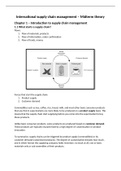International supply chain management – Midterm theory
Chapter 1 – Introduction to supply chain management
1.1 What starts a supply chain?
Flows:
1. Flow of materials, products
2. Flow of information, order confirmation
3. Flow of funds, money
Forces that start the supply chain:
1. Product supply
2. Customer demand
Commodities such as tea, coffee, rice, bread, milk, and most other basic consumer products
that you find in supermarkets are more likely to be produced on a product supply basis. This
means that the supply chain start supplying before you come into the supermarket to buy
these products.
Unlike basic consumer products, some products are produced based on customer demand.
These products are typically characterised by a high degree of customisation or product
innovation.
To summarise, supply chains can be triggered by product supply (commodities) or by
customer demand (customised products). The degree of customisation dictates how much,
and in which format the supplying company holds inventory: no stock at all, raw or basic
materials only or sub-assemblies of their products.
,1.2 A functional view of supply chain management
SCOR Generic functional processes in the supply chain:
Plan process: balance demand and supply
Source process: selecting suppliers
Make process: set up manufacturing
Deliver process: order management; logistics
Return process: post-delivery customer support
1.3 Supply chain architecture
In its simplest format, a supply chain consists of three nodes:
The company
The supplier
The customer
In an extended supply chain, we consider three additional supply chain nodes:
Supplier’s supplier
Customer’s customer
Service provider
, The supply chain players are as follows:
Suppliers
Own company
Customers
Service providers
Service providers perform services in areas such as:
Transportation
Warehousing
Finance
Market research
New product design
Technology
Sustainability
Service providers specialise in certain skills and expertise. They are often able to provide
these services more efficiently than manufacturers, distributors, wholesalers, retailers or
end customers.
Supply chain structures, however, may have more nodes involved if you look at them from
the very beginning until the very end. Drawing your own or your customer’s supply chain can
help you understand the supply chain dynamics better. When you look at your finished
supply chain map, you probably find multiple upstream and downstream nodes, including
some of service providers.
1.4 Supply chain dynamics
Although their set-up often appears to be static, supply chains in reality are quite dynamic.
Ideally, supply chains react to changes in their environment.
It is crucial to balance the rate of product supply in accordance with the rate of customer
demand. This is, as practitioners of supply chains will know, very difficult at times. External
influences will affect the equilibrium. The demand for ice cream, for example, depends on
how hot it is during the summer. Moreover, macroeconomic factors such as exchange rates
can affect world travel and consumption.
The challenge in supply chain management is to balance the level of inventory while
maintain a high level of service.
A famous simulation of dynamics in the supply chain is the beer game.






